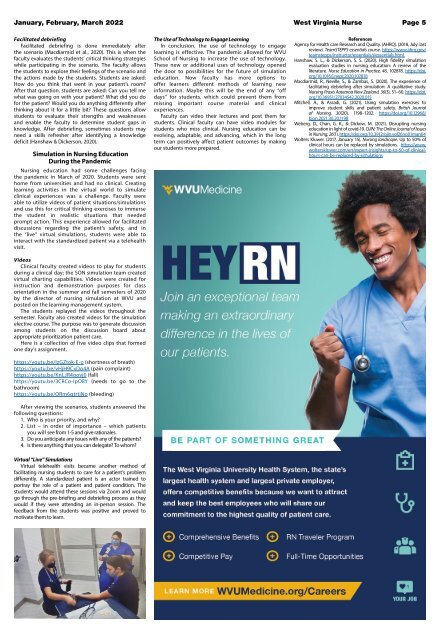West Virginia Nurse - January 2022
You also want an ePaper? Increase the reach of your titles
YUMPU automatically turns print PDFs into web optimized ePapers that Google loves.
<strong>January</strong>, February, March <strong>2022</strong> <strong>West</strong> <strong>Virginia</strong> <strong>Nurse</strong> Page 5<br />
Facilitated debriefing<br />
Facilitated debriefing is done immediately after<br />
the scenario (Macdiarmid et al., 2020). This is when the<br />
faculty evaluates the students’ critical thinking strategies<br />
while participating in the scenario. The faculty allows<br />
the students to explore their feelings of the scenario and<br />
the actions made by the students. Students are asked:<br />
How do you think that went in your patient’s room?<br />
After that question, students are asked: Can you tell me<br />
what was going on with your patient? What did you do<br />
for the patient? Would you do anything differently after<br />
thinking about it for a little bit? These questions allow<br />
students to evaluate their strengths and weaknesses<br />
and enable the faculty to determine student gaps in<br />
knowledge. After debriefing, sometimes students may<br />
need a skills refresher after identifying a knowledge<br />
deficit (Hanshaw & Dickerson, 2020).<br />
Simulation in Nursing Education<br />
During the Pandemic<br />
Nursing education had some challenges facing<br />
the pandemic in March of 2020. Students were sent<br />
home from universities and had no clinical. Creating<br />
learning activities in the virtual world to simulate<br />
clinical experiences was a challenge. Faculty were<br />
able to utilize videos of patient situations/simulations<br />
and use this for critical thinking exercises to immerse<br />
the student in realistic situations that needed<br />
prompt action. This experience allowed for facilitated<br />
discussions regarding the patient’s safety, and in<br />
the “live” virtual simulations, students were able to<br />
interact with the standardized patient via a telehealth<br />
visit.<br />
Videos<br />
Clinical faculty created videos to play for students<br />
during a clinical day; the SON simulation team created<br />
virtual charting capabilities. Videos were created for<br />
instruction and demonstration purposes for class<br />
orientation in the summer and fall semesters of 2020<br />
by the director of nursing simulation at WVU and<br />
posted on the learning management system.<br />
The students replayed the videos throughout the<br />
semester. Faculty also created videos for the simulation<br />
elective course. The purpose was to generate discussion<br />
among students on the discussion board about<br />
appropriate prioritization patient care.<br />
Here is a collection of five video clips that formed<br />
one day’s assignment.<br />
https://youtu.be/IzGZtok-E-o (shortness of breath)<br />
https://youtu.be/vHjH9CxDo4A (pain complaint)<br />
https://youtu.be/KnLJR4oovj0 (fall)<br />
https://youtu.be/3CRCo-IpO8Y (needs to go to the<br />
bathroom)<br />
https://youtu.be/ORm6qtrtjNo (bleeding)<br />
After viewing the scenarios, students answered the<br />
following questions:<br />
1. Who is your priority, and why?<br />
2. List – in order of importance – which patients<br />
you will see from 1-5 and give rationales.<br />
3. Do you anticipate any issues with any of the patients?<br />
4. Is there anything that you can delegate? To whom?<br />
The Use of Technology to Engage Learning<br />
In conclusion, the use of technology to engage<br />
learning is effective. The pandemic allowed for WVU<br />
School of Nursing to increase the use of technology.<br />
These new or additional uses of technology opened<br />
the door to possibilities for the future of simulation<br />
education. Now faculty has more options to<br />
offer learners different methods of learning new<br />
information. Maybe this will be the end of any “off<br />
days” for students, which could prevent them from<br />
missing important course material and clinical<br />
experiences.<br />
Faculty can video their lectures and post them for<br />
students. Clinical faculty can have video modules for<br />
students who miss clinical. Nursing education can be<br />
evolving, adaptable, and advancing, which in the long<br />
term can positively affect patient outcomes by making<br />
our students more prepared.<br />
References<br />
Agency for Health care Research and Quality. (AHRQ). (2018, July: last<br />
review). TeamSTEPPS essentials course. https://www.ahrq.gov/<br />
teamstepps/instructor/essentials/slessentials.html.<br />
Hanshaw, S. L., & Dickerson, S. S. (2020). High fidelity simulation<br />
evaluation studies in nursing education: A review of the<br />
literature. <strong>Nurse</strong> Education in Practice, 46, 102818. https://doi.<br />
org/10.1016/j.nepr.2020.102818<br />
Macdiarmid, R., Neville, S., & Zambas, S. (2020). The experience of<br />
facilitating debriefing after simulation: A qualitative study.<br />
Nursing Praxis Aotearoa New Zealand, 36(3), 51–60. https://doi.<br />
org/10.36951/27034542.2020.015<br />
Mitchell, A., & Assadi, G. (2021). Using simulation exercises to<br />
improve student skills and patient safety. British Journal<br />
of Nursing, 30(20), 1198–1202. https://doi.org/10.12968/<br />
bjon.2021.30.20.1198<br />
Weberg, D., Chan, G. K., & Dickow, M. (2021). Disrupting nursing<br />
education in light of covid-19. OJIN: The Online Journal of Issues<br />
in Nursing, 26(1). https://doi.org/10.3912/ojin.vol26no01man04<br />
Wolters Kluwer. (2017, <strong>January</strong> 15). Nursing landscape. Up to 50% of<br />
clinical hours can be replaced by simulations. https://www.<br />
wolterskluwer.com/en/expert-insights/up-to-50-of-clinicalhours-can-be-replaced-by-simulations<br />
Virtual “Live” Simulations<br />
Virtual telehealth visits became another method of<br />
facilitating nursing students to care for a patient’s problem<br />
differently. A standardized patient is an actor trained to<br />
portray the role of a patient and patient condition. The<br />
students would attend these sessions via Zoom and would<br />
go through the pre-briefing and debriefing process as they<br />
would if they were attending an in-person session. The<br />
feedback from the students was positive and proved to<br />
motivate them to learn.

















